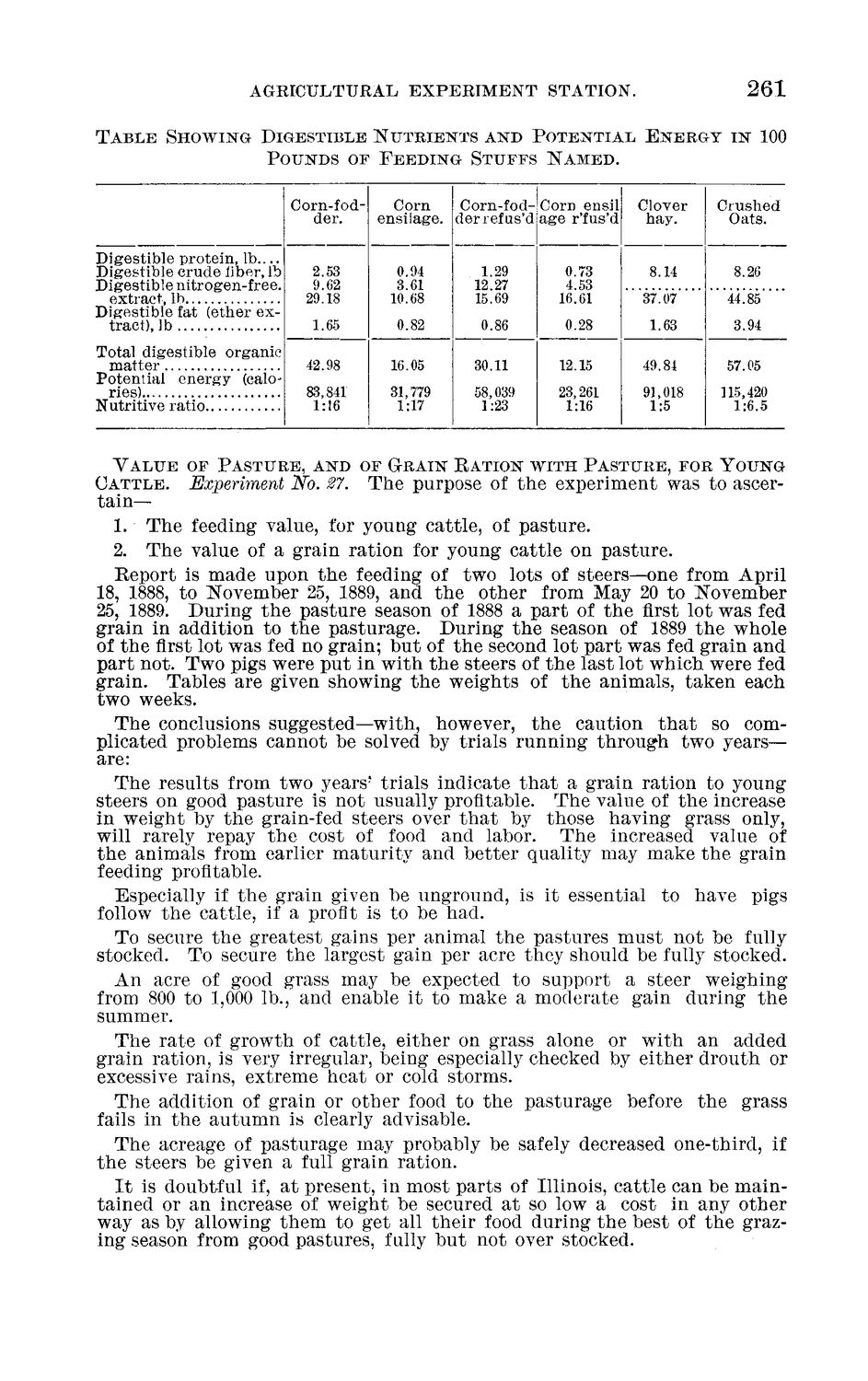| |
| |
Caption: Board of Trustees Minutes - 1890
This is a reduced-resolution page image for fast online browsing.

EXTRACTED TEXT FROM PAGE:
AGRICULTURAL EXPERIMENT STATION. 261 100 T A B L E SHOWING DIGESTIBLE N U T R I E N T S AND P O T E N T I A L E N E R G Y I N P O U N D S OF F E E D I N G S T U F F S N A M E D . Corn Corn-fodCorn-fod- Corn ensil der. ensilage. der refus'd age r'fus'd Digestible protein, l b . . . . Digestible c r u d e liber, lb Digestible nitrogen-free. extract, lb Digestible fat (ether extract), lb Total digestible organic matter Potential e n e r g y (calories) Nutritive ratio 2.53 9.62 29.18 1.65 42.98 83,841 1:16 0.94 3.61 10.68 0.82 16.05 31,779 1:17 1.29 12.27 15.69 0.86 30.11 58,039 1:23 0.73 4.53 16.61 0.28 12.15 23,261 1:16 Clover hay. 8.14 37.07 1.63 49.81 91,018 1:5 Crushed Oats. 8.26 44.85 3.94 57.05 115,420 1:6.5 V A L U E OF P A S T U R E , AND OF G R A I N E A T I O N W I T H P A S T U R E , FOR YOUNG CATTLE. Experiment No. 27. The purpose of the experiment was to ascertain— 1. The feeding value, for young cattle, of pasture. 2. The value of a grain ration for young cattle on pasture. Eeport is made upon the feeding of two lots of steers—one from April 18, 1888, to November 25, 1889, and the other from May 20 to November 25, 1889. During the pasture season of 1888 a part of the first lot was fed grain in addition to the pasturage. During the season of 1889 the whole of the first lot was fed no grain; but of the second lot part was fed grain and part not. Two pigs were put in with the steers of the last lot which were fed grain. Tables are given showing the weights of the animals, taken each two weeks. The conclusions suggested—with, however, the caution t h a t so complicated problems cannot be solved by trials running through two years— are: The results from two years' trials indicate t h a t a grain ration to young steers on good pasture is not usually profitable. The value of the increase in weight by the grain-fed steers over t h a t by those having grass only, will rarely repay the cost of food and labor. The increased value of the animals from earlier maturity and better quality may make the grain feeding profitable. Especially if the grain given be unground, is it essential to have pigs follow the cattle, if a profit is to be had. To secure the greatest gains per animal the pastures must not be fully stocked. To secure the largest gain per acre they should be fully stocked. An acre of good grass may be expected to support a steer weighing from 800 to 1,000 lb., and enable it to make a moderate gain during the summer. The rate of growth of cattle, either on grass alone or with an added grain ration, is very irregular, being especially checked by either drouth or excessive rains, extreme heat or cold storms. The addition of grain or other food to the pasturage before the grass fails in the autumn is clearly advisable. The acreage of pasturage may probably be safely decreased one-third, if the steers be given a full grain ration. I t is doubtful if, at present, in most parts of Illinois, cattle can be maintained or an increase of weight be secured at so low a cost in any other way as by allowing them to get all their food during the best of the grazing season from good pastures, fully but not over stocked.
| |